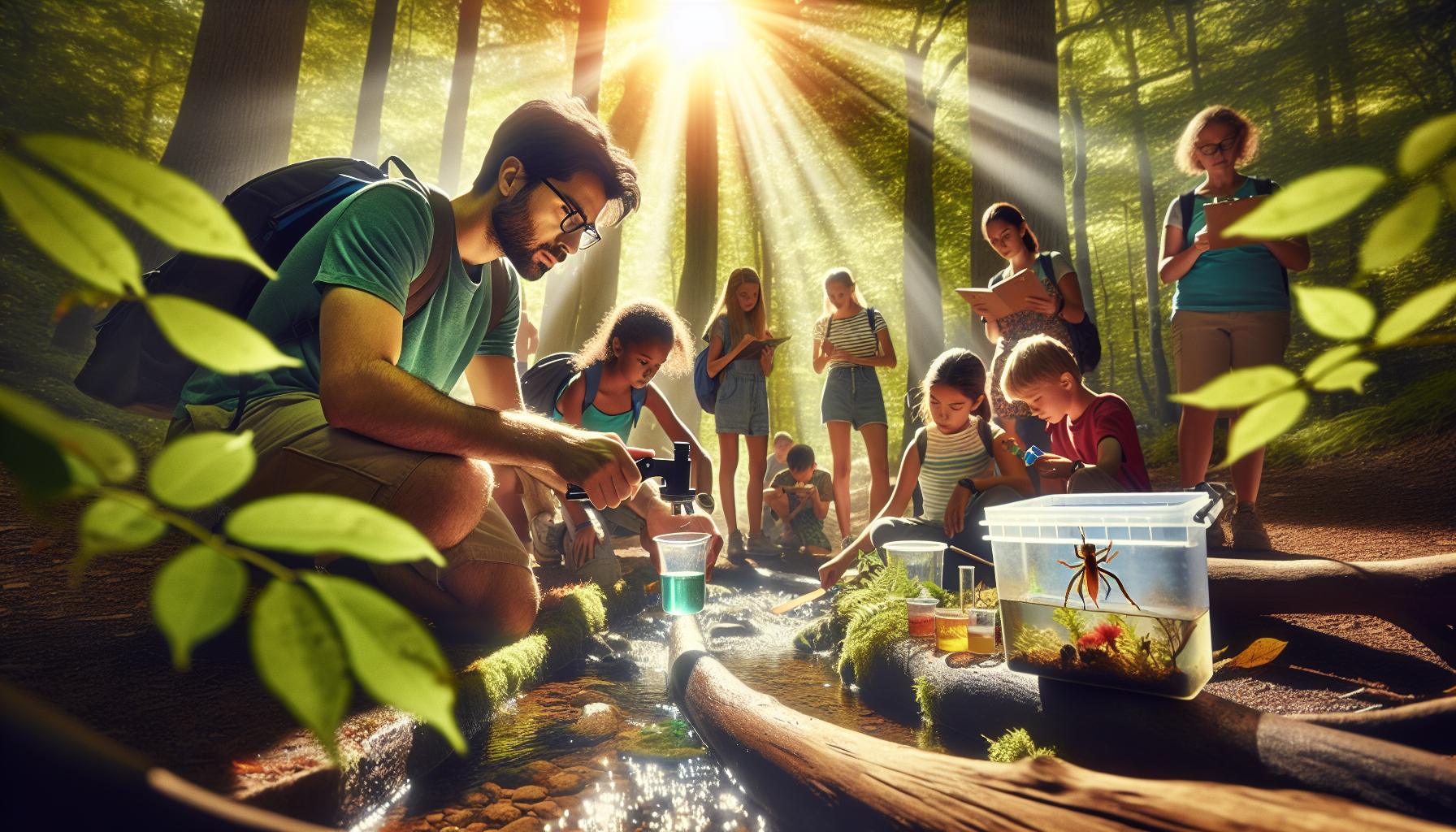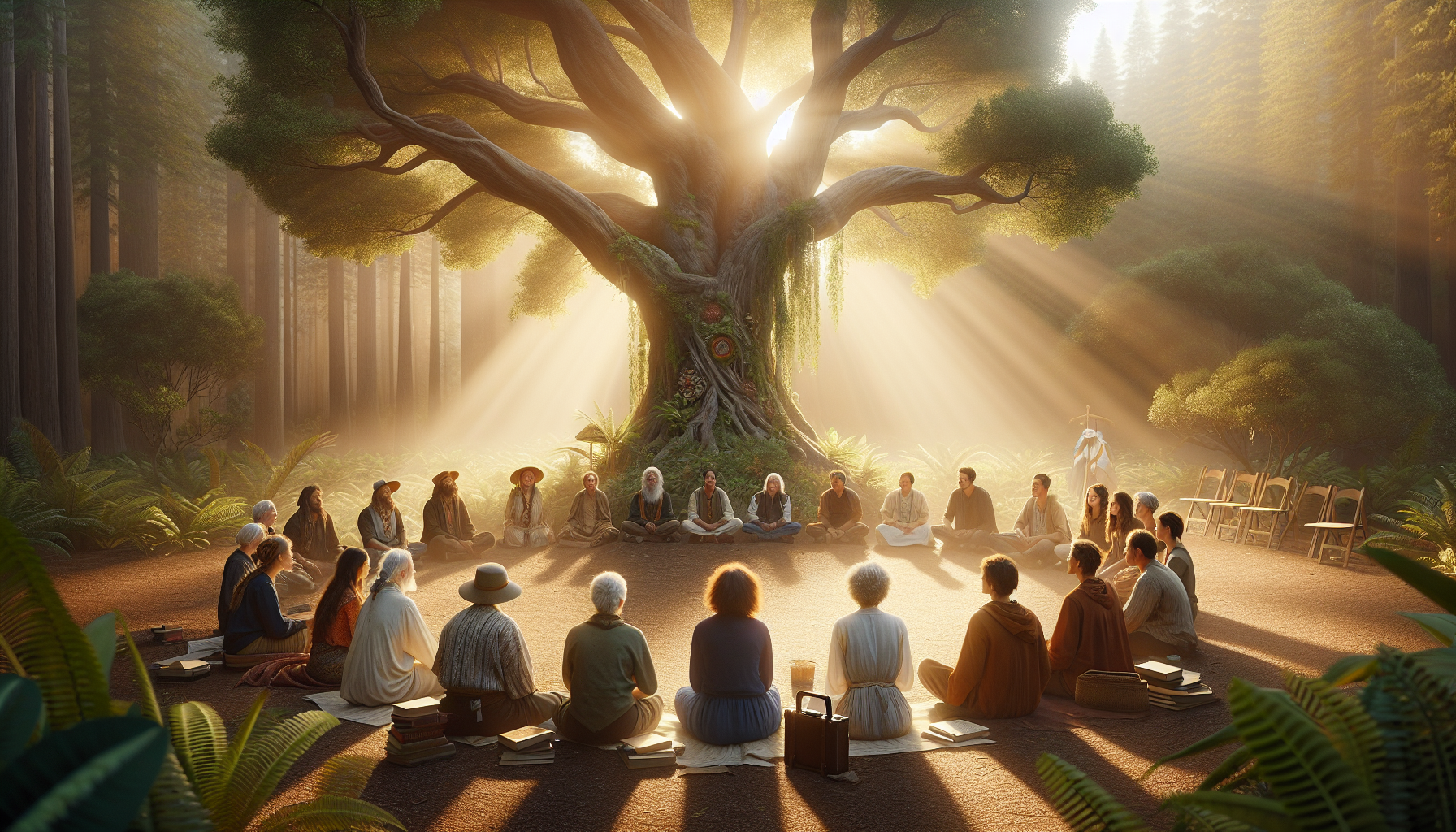Imagine a world where the boundaries between science and nature dissolve into a seamless tapestry of discovery and adventure. A place where the forest becomes your laboratory, the mountain trails your classroom, and the bubbling streams your experimental playground. Welcome to the exciting realm of Trailside Adventures, where we invite outdoor enthusiasts to unleash their inner scientist through engaging, hands-on activities that bridge the gap between empirical inquiry and the wonders of the natural world 🌲🔍. Whether you’re a seasoned hiker, a weekend camper, or someone who simply revels in the beauty of the great outdoors, this is your chance to deepen your connection with nature by exploring the scientific marvels it holds.
In this article, we embark on a journey to rediscover the magic of nature through the lens of scientific exploration. Our adventure begins by examining the fundamental question: why is it important to integrate science with our outdoor experiences? From understanding ecological systems to grasping the mechanics of weather patterns, science enhances our appreciation for the environments we cherish. We will delve into the multifaceted benefits of engaging in science-based outdoor activities, which range from fostering a greater environmental consciousness to enhancing mental and physical well-being. Moreover, we will explore how these activities can be a powerful tool for education, sparking curiosity and critical thinking in participants of all ages.
But what does it mean to unleash your inner scientist in the wild? Throughout this exploration, we’ll introduce a range of thrilling activities designed to ignite your curiosity and expand your knowledge. Picture yourself participating in a citizen science project, where you contribute to real-world research by observing and recording local wildlife. Or imagine the thrill of identifying geological formations and understanding the forces that shaped them over millennia. You’ll also discover how to track weather changes and predict patterns using simple tools, and even learn to navigate using celestial bodies. These activities are not just about acquiring new skills; they are about transforming your outdoor experience into an interactive, enriching journey of scientific discovery.
As we dive deeper, we’ll provide practical tips on how to incorporate these science activities into your own adventures, regardless of your level of expertise or the environments you frequent. We will offer guidance on essential tools and techniques, safety considerations, and ways to engage family and friends in these enriching experiences. By the end of this article, you’ll be equipped with a toolkit of ideas and insights to elevate your outdoor excursions into immersive, educational endeavors. So, lace up your hiking boots, grab your field journal, and prepare to embark on an adventure that will not only invigorate your body and soul but will also awaken the scientist within you. Let’s set forth on this exciting path of discovery together! 🌍🔬
Exploring Nature Through Science: A New Perspective
Embracing the wonders of science while basking in the great outdoors is an invigorating way to ignite your inner scientist. Whether you’re a seasoned naturalist or a curious beginner, integrating scientific exploration with outdoor activities can transform the way you perceive nature. The beauty of this approach lies in its ability to foster a deeper understanding of the natural world, enhancing both your scientific knowledge and your appreciation for nature’s intricate ecosystems. 🌿
Science doesn’t have to be confined to a laboratory or classroom. By taking your experiments outside, you unlock a realm of possibilities, allowing you to observe, hypothesize, and experiment in real-world settings. Outdoor science activities can be as simple as studying the life cycle of a butterfly or as complex as measuring the acidity levels in a nearby stream. Each endeavor invites you to engage with your surroundings in meaningful ways, transforming every walk or hike into an opportunity for discovery.
One of the most exciting aspects of conducting science activities outdoors is the unpredictability of nature. Unlike controlled environments, the outdoors offers a dynamic setting where variables are in constant flux. This variability challenges you to adapt your experiments, fostering critical thinking and problem-solving skills. Moreover, outdoor science activities promote physical activity and encourage teamwork, making them ideal for group settings or family outings. To dive deeper into this topic, watch the video “Outdoor Science Activities for Families” by National Geographic on their YouTube channel.
The Essentials of Planning Outdoor Science Activities
When planning outdoor science activities, it’s crucial to consider several factors to ensure a rewarding experience. First and foremost, safety should be your top priority. This involves choosing appropriate locations, understanding the potential risks of certain experiments, and equipping yourself with the necessary gear and supplies. Whether you’re measuring wind speed atop a hill or identifying plant species in a dense forest, preparation is key to a successful outing. 🧭
Another important aspect of planning is setting clear objectives for your activities. Having a defined goal in mind will guide your exploration and provide a framework for your experiments. Objectives can range from learning about the geological features of a region to understanding the behavioral patterns of local wildlife. These goals not only provide direction but also allow for measurable outcomes, adding a layer of scientific rigor to your adventures.
Additionally, consider the educational value and engagement level of your chosen activities. Opt for experiments that are both informative and enjoyable, ensuring that participants remain interested and motivated. Utilizing a mix of observation, experimentation, and data collection can make the experience more comprehensive and rewarding. Remember, the goal is to foster a love for science and nature, so keep activities fun and accessible. For inspiration, check out the table below that compares various outdoor science activities based on difficulty, duration, and required materials.
| Activity | Difficulty | Duration | Materials Required |
|---|---|---|---|
| Bird Watching | Easy | 1-2 hours | Binoculars, Notebook |
| Stream Water Testing | Moderate | 2-3 hours | pH Kit, Thermometer |
| Geological Survey | Advanced | Half-day | Compass, Rock Hammer, GPS |
Hands-On Science Experiments: Engaging the Senses
Hands-on science experiments are a fantastic way to engage all the senses, offering a full-bodied experience that enhances learning and retention. By touching, seeing, smelling, and even hearing the natural world, you immerse yourself in a multi-sensory exploration that books and screens simply cannot replicate. These experiments provide tangible connections to abstract scientific concepts, bridging the gap between theory and practice.
For example, consider the simple yet enlightening experiment of creating a leaf chromatography. This activity not only showcases the hidden colors within leaves but also introduces participants to the concept of pigments and their roles in photosynthesis. By using common household items like coffee filters and rubbing alcohol, you can easily conduct this experiment in any outdoor setting, turning a mundane walk into a fascinating investigation of plant biology.
Additionally, engaging the sense of sound can offer unique insights into the natural world. Setting up a simple sound map, where participants sit quietly and mark the origin of different sounds they hear, can foster an appreciation for the acoustic environment. This activity highlights the diversity of wildlife and the subtle nuances of their interactions, making it a perfect complement to more visually focused experiments. For a deeper understanding of how to execute these experiments, watch the video “Leaf Chromatography – Simple Science Experiments” by Science Buddies on YouTube.
Incorporating Technology into Outdoor Science
In today’s digital age, technology can be a powerful ally in outdoor science activities. From smartphones equipped with powerful cameras to apps that identify plants and animals, modern tools can enhance and expand the scope of your scientific investigations. Utilizing technology allows for the collection and analysis of data in ways that were once unimaginable, opening new avenues for exploration and discovery. 📱
One of the simplest ways to incorporate technology is through photography and video recording. Documenting your experiments and observations provides a visual record that can be analyzed later, offering new insights and perspectives. Moreover, sharing these findings on social media or dedicated science platforms can connect you with a broader community of outdoor enthusiasts and scientists, fostering collaboration and the exchange of ideas.
Apps like iNaturalist or Seek by iNaturalist can also be invaluable tools for outdoor science activities. These apps leverage crowd-sourced data and advanced algorithms to help identify species, making them perfect companions for fieldwork. By taking advantage of these resources, you not only enhance your understanding of the natural world but also contribute to a global database of biodiversity information. For a comprehensive guide on how to use technology in your outdoor adventures, refer to the video “How to Use iNaturalist to Observe Nature” by Project Noah on YouTube.
Connecting with Nature: The Benefits Beyond Science
While the scientific benefits of engaging in outdoor activities are significant, the advantages extend far beyond academic enrichment. Connecting with nature through science fosters a holistic sense of well-being, enhancing mental, emotional, and physical health. The act of immersing oneself in the natural world can be profoundly therapeutic, reducing stress, boosting mood, and improving overall quality of life.
Research has shown that spending time in nature can lead to increased levels of serotonin and dopamine, the neurotransmitters responsible for feelings of happiness and relaxation. This natural mood enhancement makes outdoor science activities not only intellectually rewarding but also emotionally uplifting. Whether you’re measuring the height of a tree or observing the behavior of insects, the tranquility and beauty of nature offer a perfect antidote to the stresses of modern life.
Furthermore, engaging in scientific exploration outdoors can foster a sense of stewardship and responsibility towards the environment. By understanding the intricacies of ecosystems and the impact of human activity, individuals are more likely to adopt sustainable practices and advocate for environmental conservation. This sense of purpose and connection to the natural world can be incredibly empowering, instilling a lifelong passion for science and nature. For more on the mental health benefits of nature, watch the video “The Healing Power of Nature” by BBC Earth on YouTube.
- Explore diverse ecosystems and their unique characteristics.
- Engage in experiments that enhance your understanding of nature.
- Utilize technology to broaden your scope of exploration.
- Foster a deeper connection with the environment.
- Experience the therapeutic benefits of spending time outdoors.

Conclusion
In our exploration of “Unleash Your Inner Scientist with Trailside Adventures: Exciting Hands-On Science Activities for Outdoor Enthusiasts,” we’ve ventured into the fascinating intersection of science and nature, a realm where curiosity meets exploration and learning thrives in the great outdoors. This journey has underscored the profound impact that hands-on science activities can have on enhancing our understanding of the natural world, fostering a deeper appreciation for the environment, and igniting a lifelong passion for discovery.
Throughout the article, we’ve delved into a variety of engaging and educational activities that outdoor enthusiasts can embrace. From identifying local flora and fauna to conducting simple ecological surveys, these experiences not only enrich our knowledge but also empower us to become active participants in the preservation of our ecosystems. By encouraging a scientific approach to our adventures, we transform ordinary hikes and outings into extraordinary opportunities for learning and growth.
One of the central themes we’ve explored is the democratization of science through accessible and interactive experiences. You don’t need to be a trained scientist to engage in meaningful scientific exploration. With a few tools and a curious mind, anyone can partake in these activities, making science approachable and enjoyable for individuals of all ages and backgrounds. This democratization fosters a sense of inclusivity, ensuring that everyone has the opportunity to contribute to scientific understanding and environmental stewardship.
Moreover, we’ve highlighted the importance of citizen science projects, which empower individuals to contribute valuable data to scientific research efforts. These projects bridge the gap between professionals and enthusiasts, creating a collaborative network that advances scientific knowledge while simultaneously nurturing a community of informed and engaged citizens. By participating in these initiatives, you not only contribute to important research but also gain a sense of fulfillment and purpose, knowing that your efforts are making a tangible difference.
The significance of these activities extends beyond personal enrichment; they play a crucial role in addressing broader environmental challenges. As we face global issues such as climate change, biodiversity loss, and habitat degradation, it becomes increasingly important for individuals to cultivate a scientific mindset and an informed perspective. By engaging in trailside adventures, we equip ourselves with the knowledge and skills needed to advocate for sustainable practices and contribute to conservation efforts.
The hands-on nature of these activities enhances our understanding of complex ecological systems, making abstract concepts more tangible and comprehensible. This experiential learning approach resonates deeply, fostering a sense of connection to the natural world and motivating us to protect it for future generations. By cultivating this connection, we inspire others to embark on similar journeys of exploration and discovery, creating a ripple effect of awareness and action that extends far beyond our individual experiences.
As we conclude this exploration, it’s important to recognize that the journey doesn’t end here. The world is a vast and wondrous place, teeming with opportunities for scientific discovery and adventure. I encourage you to take the insights and inspiration gained from this article and apply them in your own outdoor pursuits. Whether you’re hiking through a forest, exploring a coastal ecosystem, or simply observing the wildlife in your local park, there are countless ways to engage your inner scientist and deepen your connection with nature.
Share your experiences and insights with others, fostering a community of like-minded individuals who are passionate about science and the environment. By sharing our stories and knowledge, we create a network of support and encouragement, empowering more people to embark on their own trailside adventures. Your experiences can inspire others to see the world through a scientific lens, igniting their curiosity and encouraging them to take action in their own unique ways.
Moreover, consider participating in citizen science projects or starting your own local initiatives. There are numerous online platforms and organizations that facilitate citizen science, providing resources and guidance for individuals eager to contribute to scientific research. These initiatives not only enhance our understanding of the natural world but also demonstrate the power of collective action in addressing pressing environmental issues. Here are a few resources to get you started:
1. iNaturalist – A platform that allows you to record your observations of plants and animals, contributing to a global database used by scientists and researchers.
2. Zooniverse – A hub for citizen science projects across various fields, where you can assist researchers by classifying data and making observations.
3. Project BudBurst – A citizen science project focused on plant phenology, helping scientists understand how plants respond to changing climates.
In conclusion, “Unleash Your Inner Scientist with Trailside Adventures” is more than a call to action; it’s an invitation to embark on a transformative journey of discovery and connection. By engaging in hands-on science activities, we enrich our understanding of the natural world, foster a sense of stewardship, and inspire others to join us in this important endeavor. Let’s continue to explore, learn, and advocate for the environment, unleashing our inner scientists and paving the way for a more informed and sustainable future. 🌿🔬
I invite you to comment below with your thoughts, share this article with fellow outdoor enthusiasts, and embark on your own trailside adventures. Together, we can make a meaningful impact, one step at a time.
Toni Santos is a visual storyteller and educational ethnographer whose work celebrates the fluid knowledge systems of nomadic cultures. Through art and research, Toni brings attention to how learning has thrived outside traditional institutions—rooted in movement, oral tradition, and deep connection to land and community.
Guided by a passion for ancestral wisdom, adaptive pedagogy, and cultural resilience, Toni explores the tools, rituals, and environments that once shaped the minds of travelers, herders, and migrating communities. Whether illustrating storytelling circles beneath open skies, wearable mnemonic devices, or maps woven into textiles, Toni’s work honors learning as a lived, sensory, and communal experience.
With a background in visual anthropology and intercultural design, Toni reconstructs the educational models of mobile societies through images and narratives that restore their dignity and relevance in today’s world.
As the creative mind behind Vizovex, Toni shares a rich tapestry of visual essays, artifact-inspired art, and curated stories that reveal the genius of teaching and learning on the move.
His work is a tribute to:
The wisdom of learning through journey, rhythm, and story
The spatial and environmental intelligence of nomadic cultures
The power of intergenerational knowledge passed outside walls
Whether you’re an educator, researcher, or lifelong learner, Toni invites you to step into a world where education is not confined, but carried—one step, one song, one shared insight at a time.





